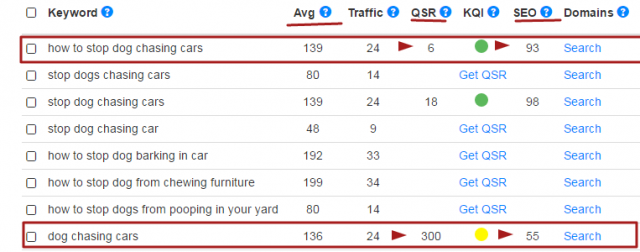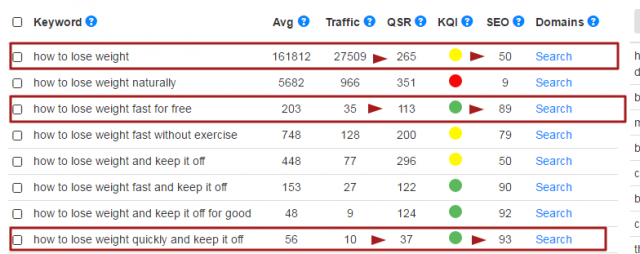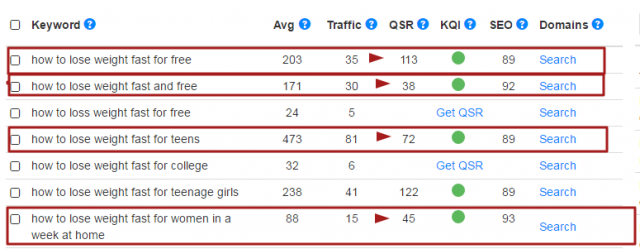As a website owner, keyword research is one of the most important things to perform.  In my post, I will not only show you what long tail keyword research is but also how it will help you increase your rankings in Google and other search engines.
In my post, I will not only show you what long tail keyword research is but also how it will help you increase your rankings in Google and other search engines.
In my article What’s The Best Keyword Research Tool, I described the three competitive metrics for keywords that give you a good chance to rank on Google’s page 1.
A long tail keyword is basically a longer phrase you would type into google’s search bar. If I am looking for something on the Internet, I usually a particular idea of what I want to know.
In fact, 70% of all search queries are for long tail keywords.
Here is a real life example: my dog is chasing cars. So I would like to know, how I can stop her from chasing cars.
Instead of just typing “dog chases cars,” I am more specific and say “how can I stop my dog chasing cars.” This phrase is a long tail keyword and should give me website suggestions with this phrase in it.
Benefit: I, as a reader, find the solution to my problem quicker. For you as a website owner, if you used this particular phrase as your keyword in your post, it will most likely rank high in Google.
How Do I Research Long Tail Keywords?
Your best bet is to use an efficient and easy to use keyword research tool. My preferred one is Jaaxy. (read my full review here)
I am going to use the same example about my dog chasing cars. Please have a look at my screenshot.

So you can see my two phrases: ‘dog chasing cars’ and ‘how to stop dog chasing cars.’ Both phrases get similar traffic, but the QSR (Competing Search Result) shows a huge difference as well as the SEO factor.
Which one would you choose? The phrase with a QSR of 6 and SEO rating of 93 or QSR of 300 and SEO of 55?
Here lays the power of long tail keywords. The more specific your phrase aka keyword is the better your chances of competing against other websites and ranking in the search engines.
That brings me to another subject.
What Is Low Hanging Fruit
When we talk about long tail keywords, then the term ‘low-hanging fruit’ keyword is something you should know more about.
Both terms are closely related, and I will show you how.
When you are searching for long tail keywords, you want to look out for keywords that have a good number of monthly searches but also a low number of competing websites.
These two metrics, good amount of monthly searches plus a low number of competing websites equals the low hanging fruit.
The idea is to get rankings in Google. The approach of targeting ‘low hanging fruit’ is essential for new sites to establish themselves in the search engines and get traffic.
I am usually looking for keywords that have a QSR of under 100 or even under 50. The monthly searches should be at around 100. It may not seem a lot of traffic, but when you add posts to your website at least twice a week, the number of visitors soon increases.
Here is an example of a low hanging fruit keyword. I am using the “Losing weight” niche which is an evergreen niche. It means there will always be a need for more information on losing weight.
First Example

The phrase ‘how to lose weight’ is very broad and even though it shows lots of traffic, the QSR with 265 is by far too high and also the SEO factor of 50 is not the best.
But it is getting better when we look at ‘how to lose weight quickly and keep it off.’ This phrase is a prime example for a long tail keyword and a low hanging fruit. Only 37 competing websites and a high SEO score of 93.
In my second example, I am looking closer at the keyword ‘how to lose weight fast for free’ (second box in the screenshot) I like the number of average searches, but the competition of 113 websites are still a bit high. Maybe we can find a better keyword.
My Second Example

When we use instead ‘how to lose weight fast for free‘ with ‘how to lose weight fast and free,’ we get a much better result. The QSR is down to 38, and the SEO score is slightly higher.
I also marked two other phrases which would make great long tail and low hanging fruit keywords.
It Doesn’t Stop Here
I would like to emphasize that keywords with little competition don’t automatically rank you high in the search engines.
You still need to create compelling content. Content, that is visually appealing and engages with your readers.
If you publish articles on a regular basis (twice a week would be awesome) and you use low hanging fruit and long tail keywords, your website will be successful sooner or later.
Would you like to learn more about my # 1 online training platform for internet marketing? Please read my in-depth review here.
Wrapping It Up
I do hope my article shed some light on “What is long tail keyword research.”
Doing your proper research and ultimately using low competition keywords will give you a headstart to competing websites regarding SEO (Search Engine Optimization) and ranking in Google, Bing, and Yahoo.
Let’s recap the main benefits of using long tail keywords:
- Give you an advantage in getting higher rankings
- They are less competitive than broad keywords
- Higher SEO score
- Visitors to your site are more targeted (keyword is more specific) therefore better conversion, e.g., when you have a product review page.
If you want to do a fast and efficient long tail keyword research, I recommend using Jaaxy. As you have seen in my examples it shows you the most important factors like competing websites and the SEO score at a glance.
It makes the long tail keyword research a breeze. Try it for yourself.
⇒ Sign up for your free account here ⇐
(no credit card required)
Please let me know if you have any questions or feedback. Just drop a comment in the box below.

Be First to Comment